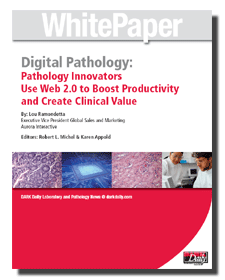Enriched exchange of digital pathology images and clinical knowledge is the goal
Digital scanning and digital pathology systems represent a major transformational force in the field of anatomic pathology. Momentum in favor of wider adoption by pathologists and pathology laboratories continues to build, reinforced, in part, by an interesting new development, which one pathologist calls “Pathology 2.0.”
Pathology 2.0 describes how Web 2.0 functions can be integrated with digital imaging and digital pathology systems to improve the productivity and quality of pathology workflow. It was Keith Kaplan, M.D., Associate Professor of Pathology and Laboratory Medicine at the Mayo Clinic in Rochester, Minnesota, who first articulated the intersection of digital scanning and digital pathology systems with Web 2.0 functions as the core of Pathology 2.0, a term he coined.
Kaplan represents the upcoming young generation of pathologists who are fundamentally digital in their vision of how the practice of anatomic pathology will evolve. In a recent Dark Daily e-briefing, Kaplan stated “Think of Pathology 2.0 as a channel to allow your pathology lab to externalize content that was once locked behind the walls of your institution. Now your pathology group, in a very easy manner—and at little or no cost—can make that information available to support collaborative discussions using expertise, knowledge, and know-how beyond your own group, your own institution, and your own healthcare system.” (See Dark Daily, September 15, 2009, Introducing “Pathology 2.0” as a Transformational Factor in Surgical Pathology.)
Kaplan’s predictions have validation in the pathology marketplace. A company based in Montreal, Quebec, is selling a pathology product that seems to meet several attributes of the Pathology 2.0 concept. The mScope system sold by Aurora MSC is described as a “digital pathology communications” system that is a “universal web viewer with collaborative tools to view all medical images anytime, anywhere.” Pathology laboratories in the North America and Europe already use this system. That might make these labs frontrunners in efforts to actualize the Pathology 2.0 concept.
What is intriguing about Aurora MSC’s niche in the pathology marketplace is that is not selling a hardware solution. Rather, it offers pathology laboratories a suite of capabilities to foster improved communication between pathologists, referring physicians, and even patients—supported by access to digital images and an integrated electronic health record (EHR). In a sense, this is a middleware solution that supplements the traditional pathology laboratory information system (PLIS). In another sense, it is the portal that puts the pathology group onto the information superhighway so it can share its images, expertise, and knowledge in new ways that add value to physicians and patients.
For pathologists, pathology practice administrators, and clinical laboratory managers who want to further understand the concept of Pathology 2.0 and how it may shape the evolution of anatomic pathology, Dark Daily has published a White Paper, “Pathology Innovators Use Web 2.0 to Boost Productivity and Create Clinical Value.” It is a free download and one of the first published studies of the Pathology 2.0 phenomenon.
This White Paper addresses the concepts and characteristics that define Pathology 2.0. It describes how the user experience of Web 2.0 is different from that of Web 1.0. It then shows how Web 2.0 functions work in a Pathology 2.0 setting. For pathologists interested in establishing collaborative networks that can foster clinical collaboration and lead to increased compensation, the White Paper provides insights and offers lessons learned from first mover pathology laboratories. Building on this information, the White Paper then addresses how pathology groups can use digital scanning and digital pathology systems in ways to support improved work flow, productivity, and clinical consultations.
Because the pathology profession is in the earliest stages of adopting digital imaging, digital pathology systems, and enriched Web 2.0 functions, there is still much to be understood as to how these technologies will reshape pathology as it is practiced today. The best evolutionary model available for pathologists to study is probably the adoption curve of digital images in radiology and how it changed that specialty’s clinical practices and delivery models. NightHawk pathology, anyone?
Related Information:
Introducing “Pathology 2.0” as a Transformational Factor in Surgical Pathology
Manifest destiny—Pathology 2.0 is here, and it’s clear. Time to climb aboard




